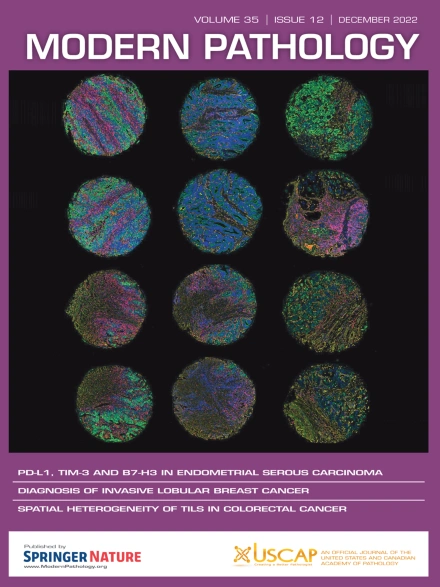eloc突变肾细胞癌是一种罕见的惰性肿瘤,具有独特的基因组特征
IF 5.5
1区 医学
Q1 PATHOLOGY
引用次数: 0
摘要
elc突变型肾细胞癌(elc -RCC)是世界卫生组织于2022年首次发现的一种RCC亚型,其分子定义为存在ELOC突变而缺乏VHL突变。在这里,我们提出了一系列的elc -RCC,并提供了深入的遗传比较与vhl -无透明细胞RCC (vhl - ccrcc)。在我们的机构细胞遗传学数据库中的1209例rcc中,我们确定了16例候选病例,这些病例最初被归类为ccRCC,并表现出单体8和完整的3p染色体。根据组织形态学、免疫组织化学和全外显子组测序结果,16例候选病例中有7例被诊断为ELOC-RCCs。相比之下,eloc - rcc具有更简单的单体8核型,其他改变很少。加上癌症基因组图谱队列中发现的另外6例elc - rcc病例,所有13例elc - rcc均表现为双等位基因ELOC失活,无VHL突变。这些ELOC突变(Y79C/L/S/N、E92K、A106D和C112Vfs * 3)均位于ELOC蛋白的vhl结合域内或附近;69%的elc - rcc表现出其特有的组织形态。与分期和分级匹配的vhl - ccrcc相比,eloc - rcc患者的总生存率更高(风险比,0.32;95%置信区间为0.16-0.61;P = .02)和无进展生存期(风险比,0.16;95%置信区间为0.06-0.42;P = 0.04)。与vhl - ccrcc相比,eloc - rcc的体细胞拷贝数改变更少,突变特征SBS1的丰度更高。eloc - rcc缺乏ccRCC常见的染色体改变或基因突变,包括PBRM1、SETD2、BAP1、TSC1、TSC2或mTOR。大多数elc - rcc具有线性系统发育树,具有克隆和截尾ELOC突变,而额外的ELOC改变或8q损失发生在亚克隆事件中。虽然13例eloc - rcc中有11例局限于肾脏,但2例eloc - rcc是高分期的,表现为大的实性肺泡型,肿瘤坏死,更多的体细胞拷贝数改变,以及额外的单等位基因VHL拷贝丢失。总的来说,eloc - rcc表现出独特的基因组特征和惰性行为,支持它作为一个独立的诊断实体。本文章由计算机程序翻译,如有差异,请以英文原文为准。
ELOC-Mutated Renal Cell Carcinoma is a Rare Indolent Tumor With Distinctive Genomic Characteristics
ELOC-mutated renal cell carcinoma (ELOC-RCC) is a subtype of RCC first recognized by the World Health Organization in 2022, molecularly defined by the presence of ELOC mutations and the lack of VHL mutations. Here, we present an institutional series of ELOC-RCC and provide an in-depth genetic comparison to VHL-null clear cell RCC (VHL-ccRCCs). Among 1209 RCCs in our institutional cytogenetics database, we identified 16 candidate cases that were originally classified as ccRCC and exhibited monosomy 8 and intact chromosome 3p. Seven of these 16 candidate cases were diagnosed as ELOC-RCCs based on histomorphology, immunohistochemistry, and whole-exome sequencing results. By contrast, ELOC-RCCs had a simpler karyotype of monosomy 8 with few other alterations. Adding 6 additional ELOC-RCC cases identified from The Cancer Genome Atlas cohort, all 13 ELOC-RCCs exhibited biallelic ELOC inactivation without VHL mutations. These ELOC mutations (Y79C/L/S/N, E92K, A106D, and C112Vfs∗3) were all located within or close to the VHL-binding domains in ELOC protein; 69% of the ELOC-RCC cases exhibited its characteristic histomorphology. Compared with stage- and grade-matched VHL-ccRCCs, patients with ELOC-RCCs had superior overall survival (hazard ratio, 0.32; 95% confidence intervals, 0.16-0.61; P = .02) and progression-free survival (hazard ratio, 0.16; 95% confidence intervals, 0.06-0.42; P = 0.04). ELOC-RCCs had significantly fewer somatic copy number alterations and a greater abundance of the mutational signature SBS1 than VHL-ccRCCs. ELOC-RCCs lacked common chromosomal alterations or gene mutations seen in ccRCC, including PBRM1, SETD2, BAP1, TSC1, TSC2, or mTOR. Most ELOC-RCCs had linear phylogenetic trees with clonal and truncal ELOC mutations, whereas additional alterations to ELOC or 8q losses occurred as a subclonal event. Although 11 of 13 ELOC-RCCs were confined to the kidney, 2 ELOC-RCCs were high-stage and exhibited a large solid alveolar pattern, tumor necrosis, more somatic copy number alterations, and an additional monoallelic VHL copy loss. Taken together, ELOC-RCCs exhibit distinctive genomic features and indolent behavior in general, supporting it as an independent diagnostic entity.
求助全文
通过发布文献求助,成功后即可免费获取论文全文。
去求助
来源期刊

Modern Pathology
医学-病理学
CiteScore
14.30
自引率
2.70%
发文量
174
审稿时长
18 days
期刊介绍:
Modern Pathology, an international journal under the ownership of The United States & Canadian Academy of Pathology (USCAP), serves as an authoritative platform for publishing top-tier clinical and translational research studies in pathology.
Original manuscripts are the primary focus of Modern Pathology, complemented by impactful editorials, reviews, and practice guidelines covering all facets of precision diagnostics in human pathology. The journal's scope includes advancements in molecular diagnostics and genomic classifications of diseases, breakthroughs in immune-oncology, computational science, applied bioinformatics, and digital pathology.
 求助内容:
求助内容: 应助结果提醒方式:
应助结果提醒方式:


